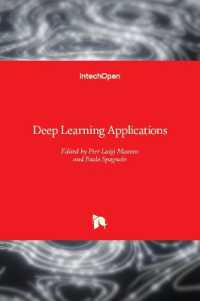- ホーム
- > 洋書
- > 英文書
- > Science / Mathematics
Full Description
An Introduction to Models and Modeling in the Earth and Environmental Sciences
offers students and professionals the opportunity to learn about groundwater modeling, starting from the basics. Using clear, physically-intuitive examples, the author systematically takes
us on a tour that begins with the simplest representations of fluid flow and builds through
the most important equations of groundwater hydrology. Along the way, we learn how
to develop a conceptual understanding of a system, how to choose boundary and initial
conditions, and how to exploit model symmetry. Other important topics covered include
non-dimensionalization, sensitivity, and finite differences. Written in an eclectic and readable
style that will win over even math-phobic students, this text lays the foundation for a
successful career in modeling and is accessible to anyone that has completed two semesters
of Calculus.
Although the popular image of a geologist or environmental scientist may be the rugged
adventurer, heading off into the wilderness with a compass and a hand level, the disciplines
of geology, hydrogeology, and environmental sciences have become increasingly quantitative.
Today's earth science professionals routinely work with mathematical and computer models,
and career success often demands a broad range of analytical and computational skills.
An Introduction to Models and Modeling in the Earth and Environmental Sciencesis written for students and professionals who want to learn the craft of modeling, and do more than just
run "black box" computer simulations.
Contents
About the companion website, xi
Introduction, 1
1 Modeling basics, 4
1.1 Learning to model, 4
1.2 Three cardinal rules of modeling, 5
1.3 How can I evaluate my model?, 7
1.4 Conclusions, 8
2 A model of exponential decay, 9
2.1 Exponential decay, 9
2.2 The Bandurraga Basin, Idaho, 10
2.3 Getting organized, 10
2.4 Nondimensionalization, 17
2.5 Solving for θ, 19
2.6 Calibrating the model to the data, 21
2.7 Extending the model, 23
2.8 A numerical solution for exponential decay, 26
2.9 Conclusions, 28
2.10 Problems, 29
3 A model of water quality, 31
3.1 Oases in the desert, 31
3.2 Understanding the problem, 32
3.3 Model development, 32
3.4 Evaluating the model, 37
3.5 Applying the model, 38
3.6 Conclusions, 39
3.7 Problems, 40
4 The Laplace equation, 42
4.1 Laplace's equation, 42
4.2 The Elysian Fields, 43
4.3 Model development, 44
4.4 Quantifying the conceptual model, 47
4.5 Nondimensionalization, 48
4.6 Solving the governing equation, 49
4.7 What does it mean?, 50
4.8 Numerical approximation of the second derivative, 54
4.9 Conclusions, 57
4.10 Problems, 58
5 The Poisson equation, 62
5.1 Poisson's equation, 62
5.2 Alcatraz island, 63
5.3 Understanding the problem, 65
5.4 Quantifying the conceptual model, 74
5.5 Nondimensionalization, 76
5.6 Seeking a solution, 79
5.7 An alternative nondimensionalization, 82
5.8 Conclusions, 84
5.9 Problems, 85
6 The transient diffusion equation, 87
6.1 The diffusion equation, 87
6.2 The Twelve Labors of Hercules, 88
6.3 The Augean Stables, 90
6.4 Carrying out the plan, 92
6.5 An analytical solution, 100
6.6 Evaluating the solution, 109
6.7 Transient finite differences, 114
6.8 Conclusions, 118
6.9 Problems, 119
7 The Theis equation, 122
7.1 The Knight of the Sorrowful Figure, 122
7.2 Statement of the problem, 124
7.3 The governing equation, 125
7.4 Boundary conditions, 127
7.5 Nondimensionalization, 128
7.6 Solving the governing equation, 132
7.7 Theis and the "well function", 134
7.8 Back to the beginning, 135
7.9 Violating the model assumptions, 138
7.10 Conclusions, 139
7.11 Problems, 140
8 The transport equation, 141
8.1 The advection-dispersion equation, 141
8.2 The problem child, 143
8.3 The Augean Stables, revisited, 144
8.4 Defining the problem, 144
8.5 The governing equation, 146
8.6 Nondimensionalization, 148
8.7 Analytical solutions, 152
8.8 Cauchy conditions, 165
8.9 Retardation and dispersion, 167
8.10 Numerical solution of the ADE, 169
8.11 Conclusions, 173
8.12 Problems, 174
9 Heterogeneity and anisotropy, 177
9.1 Understanding the problem, 177
9.2 Heterogeneity and the representative elemental volume, 179
9.3 Heterogeneity and effective properties, 180
9.4 Anisotropy in porous media, 187
9.5 Layered media, 188
9.6 Numerical simulation, 189
9.7 Some additional considerations, 191
9.8 Conclusions, 192
9.9 Problems, 192
10 Approximation, error, and sensitivity, 195
10.1 Things we almost know, 195
10.2 Approximation using derivatives, 196
10.3 Improving our estimates, 197
10.4 Bounding errors, 199
10.5 Model sensitivity, 201
10.6 Conclusions, 206
10.7 Problems, 207
11 A case study, 210
11.1 The Borax Lake Hot Springs, 210
11.2 Study motivation and conceptual model, 212
11.3 Defining the conceptual model, 213
11.4 Model development, 215
11.5 Evaluating the solution, 224
11.6 Conclusions, 229
11.7 Problems, 230
12 Closing remarks, 233
12.1 Some final thoughts, 233
Appendix A A heuristic approach to nondimensionalization, 236
Appendix B Evaluating implicit equations, 238
B.1 Trial and error, 239
B.2 The graphical method, 239
B.3 Iteration, 240
B.4 Newton's method, 241
Appendix C Matrix solution for implicit algorithms, 243
C.1 Solution of 1D equations, 243
C.2 Solution for higher dimensional problems, 244
C.3 The tridiagonal matrix routine TDMA, 244
Index, 247








